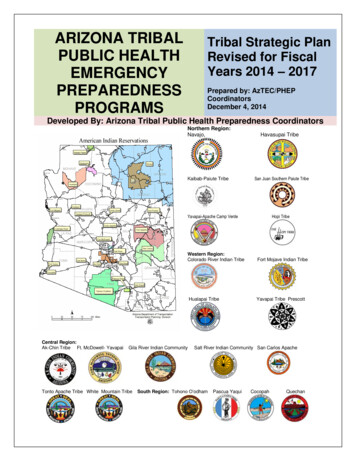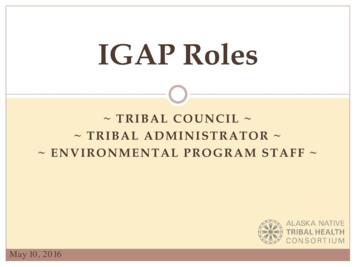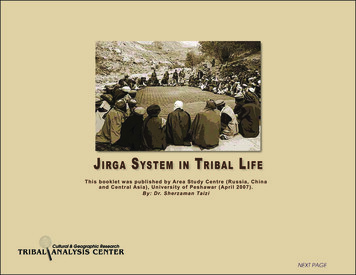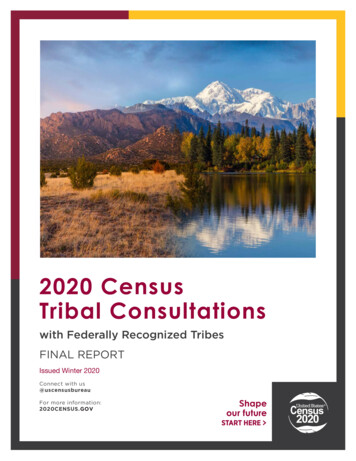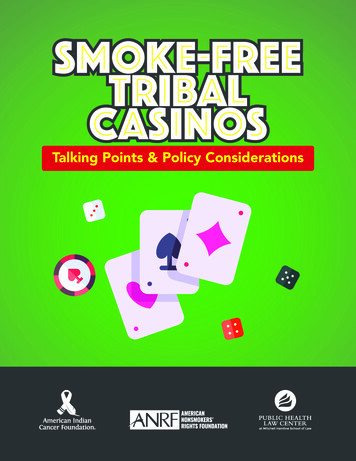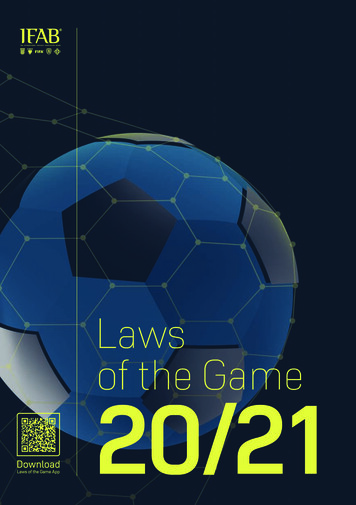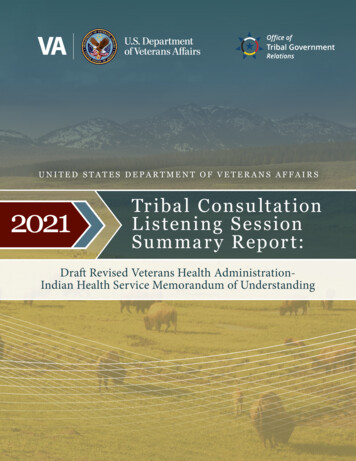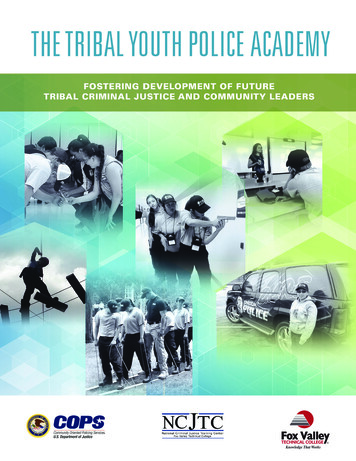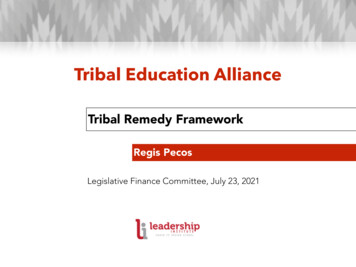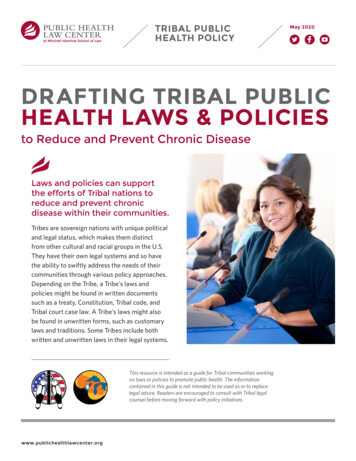
Transcription
TRIBAL PUBLICHEALTH POLICYMay 2020DRAFTING TRIBAL PUBLICHEALTH LAWS & POLICIESto Reduce and Prevent Chronic DiseaseLaws and policies can supportthe efforts of Tribal nations toreduce and prevent chronicdisease within their communities.Tribes are sovereign nations with unique politicaland legal status, which makes them distinctfrom other cultural and racial groups in the U.S.They have their own legal systems and so havethe ability to swiftly address the needs of theircommunities through various policy approaches.Depending on the Tribe, a Tribe’s laws andpolicies might be found in written documentssuch as a treaty, Constitution, Tribal code, andTribal court case law. A Tribe’s laws might alsobe found in unwritten forms, such as customarylaws and traditions. Some Tribes include bothwritten and unwritten laws in their legal systems.This resource is intended as a guide for Tribal communities workingon laws or policies to promote public health. The informationcontained in this guide is not intended to be used as or to replacelegal advice. Readers are encouraged to consult with Tribal legalcounsel before moving forward with policy initiatives.www.publichealthlawcenter.org
May 2020There are at least 574 federally recognized Tribes in the U.S. and many more Tribes that areseeking federal recognition or are state-recognized. Each Tribe has its own system of laws andgovernance. Tribal nations might or might not view written laws and other types of policies tobe useful in the same way as Western nations do. Nonetheless, many Tribes have chosen toimplement a system of written laws and policies to varying degrees. Regardless of what formTribal laws or other policies take, laws and policies that are clearly understood and supportedby community members are more likely to be sustainable. Laws and policies with communitybuy-in tend to be self-enforcing, thus requiring fewer resources to monitor and reducing thechances of negative community reactions.This publication is designed to assist Tribal leaders, health directors, public health advocates,and community members in thinking about how to draft written public health laws andpolicies for their Tribes, if that is their goal, with a focus on policies related to commercialtobacco use, healthy foods, and physical activity. It provides tips to help readers work throughthe policy writing process with the end goal of developing public health laws and policiesthat are relevant, practical, and supported by their communities. Although this publicationis an introductory general guide and is not a substitute for in-depth and tailored technicalassistance, it offers guidance and ideas developed over years of experience in working onpublic health policy development, both with Tribal and non-Tribal communities.What is policy?At the most basic level, a policy is a plan or course of action designed to influence anddetermine decisions. Policies can be written or unwritten. Written policies can take theform of Tribal codes, resolutions, treaties, executive orders, agency regulations, and othertypes of legal policies made by a Tribal government. Organizations can also have writtenpolicies, such as wellness or travel policies. Unwritten laws or policies can take the formof customary law, traditions, and organizational systems of practice.Good policies start and end with community engagementCommunity engagement is the foundation of good policy development: Communityengagement is particularly important for laws and policies related to healthy eating, activeliving, and commercial tobacco use because these policies touch on areas that are rootedin culture, connected with historical and ongoing trauma and resilience, and are intenselywww.publichealthlawcenter.orgDrafting Tribal Public Health Laws & Policies 2
May 2020Whatever form Tribal lawsand policies take, lawsand policies that areclearly understood andsupported by communitymembers are more likelyto be sustainable.personal. Through community engagement, people from across a community, including youth,elders, parents, teachers, health staff, child care providers, government staff, communityleaders, policymakers, farmers, small business owners, and others who have an interest in theproblem or issue to be addressed can bring their perspectives and experience to the policywork. Community engagement processes also raise up community members who might nothold elected positions or formal titles, but who bring valuable life experience and perspectives,www.publichealthlawcenter.orgDrafting Tribal Public Health Laws & Policies 3
May 2020or who are influential because of their relationships and reputation within the community.Engaging these natural community leaders as coalition members or policy champions will alsoassist with carrying policy initiatives forward.Community engagement leads to practical solutions: An effective community engagementprocess helps ensure that the law or policy developed will address the practical prioritiescoming from the community. Engaging community members and other key participants fromthe beginning in the policy development process not only leads to better understanding ofwhat the real needs are, but also about what approaches are more likely to work or not workon a practical level. For example, if a community were to consider creating a tax on sugarydrinks, it would be important to engage with the Tribe’s tax or revenue department, as well ascommunity members, the Tribal Council, area store owners, and community programs thatmight benefit from the tax revenues, as part of the policy development process.Community engagement leads to deeper community support: Community engagementpromotes buy-in and support from community members, and also can help anticipate andaddress potential concerns. Communicating policy intentions to the general public in a clear,consistent, and transparent way throughout the policy development process helps to preventcommunity push-back when policies are enacted. Also, inviting the general public to commenton drafted policies gives community members a chance to feel heard and invested in the policy.Community engagement requires strategic thinking and flexibility: Community engagementcan be done in different ways, and usually more than one way is a good idea. Communityengagement include: surveys, community meetings and events, individual meetings, andtalking circles. It often involves building a coalition. Different groups will have differentFigure 1: Power vs. Interest GridHigh InterestKEYSUBJECTSPLAYERSLowPowerPlayers: regularly engageHighPowerCONTEXTSETTERSCROWDSubjects: actively consultContext Setters: maintain interestCrowd: keep informedLow InterestGraphic: Rae O’Leary, Canli Coalition of the Cheyenne River Sioux Tribewww.publichealthlawcenter.orgDrafting Tribal Public Health Laws & Policies 4
May 2020degrees of involvement. Some may be community members or representatives of specificcommunity groups who actively participate in the coalition, others may be policymakers withdecision making authority, and some people may even be potential opponents to the policy.Consequently, being strategic about how and when to engage various types of perspectives androles is also important. For example, the Canli Coalition of the Cheyenne River Sioux Tribe uses apower vs. interest grid to think about how to engage different types of groups (see Figure 1).Community engagement also requires flexibility. As community needs and priorities are betterunderstood, as more perspectives are included, and as more information is gathered, the policystrategy may change or shift, although the policy goal remains constant.The Additional Resources section below includes resources that provide ideas and inspirationfor building effective community engagement. For example, the Canli Coalition of theCheyenne River Sioux Tribe’s guide for commercial tobacco policy change1 describes the roleof the coalition and how the Canli Coalition worked effectively over time to build communitysupport and achieved success in changing the commercial tobacco policy within the Tribe.The First Nation’s Development Institute’s report Indigenous Food Systems: TransformativeStrategies to Perpetuate Nationhood 2 provides case studies detailing various ways of communityengagement with food systems work across Indian Country. Also, the First Kids 1st — EveryChild is Sacred initiative’s Tribal Leadership Series guide on youth engagement3 providespractical suggestions for how to engage Tribal youth in policy initiatives.Why written laws and policies?Both written and unwritten policies are useful and can be effective. Putting policies inwriting can help promote wider awareness of a policy across a community or organization,as well as helping people coming from outside a community or organization learn aboutthe policy. Written policies can:{Provide consistency through leadership or management changes.{Facilitate consistent implementation and enforcement.{{Facilitate good understanding about what is expected of everyone — including whois responsible for implementing the policy, how it will be enforced, and the rights andresponsibilities created by the policy.Help promote a sense of fairness by aiding understanding of how the policy will be appliedacross a community, organization or department.www.publichealthlawcenter.orgDrafting Tribal Public Health Laws & Policies 5
May 2020The Drafting ProcessAt some point during the community engagement process, coalition members or advocateslikely will find it helpful to start cultivating connections, gathering policy research to help informthe policy development process, and thinking about the actual writing of the law or policy. TheCherokee Nation’s Healthy Tribal Nations Toolkit uses a simple four-step framework to describethe basic policy drafting process.4 This framework is included here with a few additions:Research: This step includes gathering research about the how the policy is expected toimpact health — for examples, how a tax could decrease sugary drink consumption, or howbreastfeeding support policies can lead to improved health outcomes for mothers and babies.It also includes gathering as much local data as possible both before and after the policyis implemented to aid in showing the policy’s actual impact. It also includes talking withadvocates who have worked on Tribal public health policy development either within the sameTribe or for other Tribes, collecting policy examples, and talking with technical assistanceproviders who may be able to provide specialized expertise on the public health issue beingfocused on, or on Tribal public health policy development in general.Research should also focus on the Tribe’s system for adopting policies and laws. Some Tribeshave complex legislative processes, while others have expedited processes. In many Tribes, theTribe’s legal counsel plays a critical role in recommending new policies or laws. It also can behelpful to know what standard or template language is typically included in the Tribe’s laws,what components are customary to include, and to get an understanding of where a new law orpolicy might fit into the Tribe’s existing policy systems. For example, a policy might fit better ina Tribal government human resources manual than in the Tribe’s legal code, or vice versa. Hereagain, the Tribe’s legal counsel will be a critical source of guidance on these questions.Engage: Engage a local policy champion or a coalition subcommittee or similar group todraft the policy. If working with a group to write the policy, it can be helpful to have a pointperson who is responsible for managing the draft and ensuring that edits are supported bythe group’s consensus. A technical assistance provider may be able to provide support forthis role. Additionally, it will be important for the group to engage in frank discussions aboutwhat compromises could be acceptable if needed to get a policy passed, and at what point itmay be better for the group to pause and come back another day. Holding these discussionsin advance can prepare the group for thinking through critical decision points under pressure.Finally, engaging the Tribe’s legal counsel early in the drafting stage can be hugely helpful — itcan help to avoid unnecessary surprises and confusion.www.publichealthlawcenter.orgDrafting Tribal Public Health Laws & Policies 6
May 2020Invite: Invite feedback through talking circles, open meetings, community meetings, one-onone conversations, and through other means of outreach appropriate for the Tribal community.Provide opportunities for community members to comment on drafts of the policy. Theseactivities can build on the foundation of community engagement that is already in place.Revise: Incorporate community and stakeholder input and feedback into the draft as much aspossible, recognizing the importance of compromise while at the same time seeking to sustainthe effectiveness of the proposed law or policy. Although this is much easier to say than to do,it is an important task that is worth the time and effort. An organization that provides legaltechnical assistance can review the draft law and help, but here again, the coalition is a crucialpart of this process.Policy ReviewTable 1 below explains the typical components of a law or policy, and provides prompts forthings to think about in drafting each component. The following principles also should be keptin mind throughout the policy development process to ensure that the law or policy is bothcomprehensive and understandable. Some of these principles can conflict with each other, suchas the goals to be specific and to be concise. Finding the right balance takes some experimenting,but applying them to a draft policy is a good way to determine the best approach.Be clear and specific{Use definitions appropriately.{Include all the necessary policy elements.{Avoid assumptions — make the meaning and intentions clear.{Communicate why the policy is needed and what change is expected.Be concise{Choose words with care and precision.{Make every word count — eliminate unnecessary words.{Keep language as simple as possible.www.publichealthlawcenter.orgDrafting Tribal Public Health Laws & Policies 7
May 2020Be consistent{{{Use language that is consistent with the law or policy objectives.Check for consistency with other parts of the policy, and consistency with other policies orlaws. For example, other written laws or policies may already define the same terms thatthe new law or policy also uses, so consistency between those sets of laws and policiescould be important for clarity. Or, if there is a need to define a term in a different way fromanother law, the policy language can make clear that the new definition applies only to thenew law or policy.Avoid unnecessary exemptions. Exemptions can undermine a law’s effectiveness, makeenforcement harder, and encourage lawsuits if people think the exemptions make the law unfair.Be practical{{Consider the ability to achieve the policy’s purpose.Consider the following factors: cost of implementation, effective date leaving enough timeto make changes, people’s ability to follow the law or policy, the ability to enforce the law orpolicy, and what kinds of consequences for violations make sense within the context of thecommunity and the offense.Be true to the community{{{{{Incorporate the Tribe’s native language, principles, and concepts into the law or policy.Use example policies but consider carefully what language to borrow or leave out, and howto tailor the law or policy to the specific community context.Avoid writing by “cut and paste” because another community’s law or policy will reflectpolitical compromises that might not be necessary or helpful.Anticipate challenges to or concerns about the proposed law or policy, including political,bureaucratic, practical and legal challenges.If exemptions are proposed, consider whether they are truly needed within the specificcommunity context, and if so, make them as narrow as possible.www.publichealthlawcenter.orgDrafting Tribal Public Health Laws & Policies 8
May 2020Photo: Robert Slocum, courtesy of the Canli Coalition of the Cheyenne River Sioux TribeBe connected{{Any new law or policy will exist within a framework of other laws and policies, and mayreflect local, national, or international trends. Draw on information from these othersources to inform the development of new policy initiatives.There are community members, other interest groups, legal technical assistance providers,and colleagues who are working on the same or similar issues. Reach out and stayconnected — ideas, inspiration, and support can come from all of these sources.www.publichealthlawcenter.orgDrafting Tribal Public Health Laws & Policies 9
May 2020Table 1: Policy ElementsFindingsFindings are brief statements of fact, data, or statistics relevant to the issuebeing addressed and that support the need for the policy. Teachings, beliefs, orprinciples specific to the Tribe could also be included. Think about:{Do the findings support the purpose of the policy?{Do the findings anticipate challenges?{Do the findings address values and purposes important to the Tribe?PurposeThe purpose is a statement that explains the goal(s) of the policy. Teachings, beliefs,or principles specific to the Tribe could also be helpful to include in this section.DefinitionsThe definitions are detailed explanations of the key words or phrases in the policy.Definitions are important for promoting understanding, but it is also important tonot go overboard and define things that do not need definition. Think about:{{{{{Main policyprovisionsWhat are the “key” terms — the words or phrases that are essential for clearand consistent understanding of what the policy is about, who or what itapplies to, who is responsible for carrying it out, etc.Are there any words or phrases that have a specialized meaning within thecontext of the policy, so that a definition is necessary?Are there words or phrases that could mean different things to differentreaders, so that a definition is helpful to avoid confusion?Are the definitions written broadly enough to encompass new or emergingconcepts or products without being overly broad?Are there any unique terms to the Tribe that warrant definition? If so, consultlocal cultural experts for assistance and reference them by name or organization.The main policy provisions state the prohibitions and/or requirements of thepolicy and identify the parties to whom the provisions apply. Think about:{Are all the requirements and prohibitions reasonable?{Do the provisions address the purpose of the policy?{Are the provisions consistent with other policies and laws of the Tribe?{Are the provisions clearly stated?{Is it clear to whom and where the policy afting Tribal Public Health Laws & Policies 10
May 2020Table 1: Policy Elements (continued)Exceptions orexemptionsEnforcementThis section contains any exemptions or exceptions to the prohibitions orrequirements that are necessary to achieve the purpose of the policy. Exceptionscan open the door to creative violations of the policy. Think about:{Are the exceptions or exemptions truly necessary?{If so, are they limited and written as narrowly as possible?The enforcement section typically identifies the parties responsible for enforcement,outlines the enforcement procedures, any penalties, fines or other consequences forviolation of the policy that may be imposed, and any appeal process. Think r.orgWhat kind of enforcement mechanisms are appropriate, considering thecommunity context and the nature of the offense?Who would be responsible for enforcing the policy?What, if any, additional resources or capacity would the Tribe need to enforcethe policy appropriately?The implementation section typically states the effective date for the policy,addresses how the policy should be publicized to community members, and describesthe steps that should or must be taken to operationalize the policy. Think about:{EvaluationWhat kind of enforcement mechanisms does the Tribe use for other policies thatmay be similar?What kind of implementation processes does the Tribe use for other policiesthat may be similar?What, if any, additional resources or capacity would the Tribe need to implementthe policy appropriately?If the policy requires significant changes or adjustments, would a delayedimplementation date be beneficial to allow people or regulated entities time tocomply with it?The evaluation section outlines the timeline and process to assess theeffectiveness of the policy, including assessing how well it is meeting the goals orwhether there are unintended consequences. It can also provide a framework forpolicy revision. Think about:{What kinds of measures make sense?{Which department or agency is best equipped to evaluate the policy?{How will the evaluation report(s) be shared with community members?{What actions should be taken in response to evaluation report(s) and by whom?Drafting Tribal Public Health Laws & Policies 11
May 2020Additional ResourcesListed below is a sampling of publications and other resources available to support Tribal policydevelopment in chronic disease prevention areas.General resources for Tribal public health policy developmentCalifornia Rural Indian Health Board, Inc.Tribal Policy, System, and Environmental Strategies for Preventing Chronic Diseasecrihb.org/wp-content/uploads/2016/11/ACORNS PSE toolkit.pdfFirst Kids 1st: Every Child Is SacredTribal Leadership Series Youth /Youth-Engagement-for-Tribal-Leaders.pdfGreat Lakes Indian Fish and Wildlife Commission and partnersDibaginjigaadeg Anishinaabe Ezhitwaad: A Tribal Climate Adaptation 1.pdfNational Congress of American IndiansTribal Public Health Law rthwest Portland Area Indian Health Board and National Indian Child Welfare AssociationTribal Policy Guide (2019) available soon from the Northwest Portland Area Indian Health Board’swebsite at www.npaihb.org.Office for State, Tribal, Local and Territorial Support, CDCTribal Public Health and the Law: Selected dfTribal Epidemiology Centerstribalepicenters.orgU.S. National Library of MedicineAmerican Indian and Alaska Native ehealth.htmlwww.publichealthlawcenter.orgDrafting Tribal Public Health Laws & Policies 12
May 2020Additional Resources (continued)Resources for Tribal food systems and policy developmentAmerican Indian Cancer FoundationHealthy Native dsFeed 7 Generationswww.feed7generations.orgFirst Nations Development InstituteKnowledge ous Food & Agriculture Initiative resourcesModel Tribal Food and Agriculture nd-ag-codeFood Safety Training for Indian Countrywww.nativefoodsafety.org]]National Farm to School NetworkFarm to School in Native Communities: Teaching the future from the esSeeds of Native Healthseedsofnativehealth.orgW. K. Kellogg FoundationIntertribal Food Systems: A National Intertribal Survey and ood-systemswww.publichealthlawcenter.orgDrafting Tribal Public Health Laws & Policies 13
May 2020Additional Resources (continued)Resources for Tribal active living policy and program developmentCalifornia Safe Routes to School Technical Assistance Resource CenterCreating Safe Routes to School Programs for Tribal Communities in rnia.pdfNotah Begay III Foundationwww.nb3foundation.orgPromoting Physical Activity Among Native American Youth: A Systematic Review of the Methodologyand Current Evidence of Physical Activity Interventions and Community-Wide Initiatives (SheilaFleischhacker et al., afe Routes to School ResourcesGrowing Safe Routes to School in Indian Country inar/srts-indian-countryWalking and Bicycling in Indian Country: Safe Routes to School in Tribal /fact-sheet/tribal-brief]]Resources for Tribal commercial tobacco control policy developmentAmerican for Nonsmokers’ RightsSmoke Free Tribal 17-11/Tribal-Casinos-4-pager FINAL.pdfThe Canli Coalition of the Cheyenne River Sioux TribeTimeline & Resource Guide for Tobacco Policy Changewww.missouri-breaks.com/canli-guideGambling with our Health: Smoke-Free Policy Would Not Reduce Tribal Casino Patronage (Isaiah“Shaneequa” Brokenleg et al., pdf/nihms745445.pdfIndigenous Peoples Task ForceCreating Healthier Policies in Indian Casinos Tribal lReportfinal 8 2007b.pdfwww.publichealthlawcenter.orgDrafting Tribal Public Health Laws & Policies 14
May 2020Additional Resources (continued)National Native Networkkeepitsacred.orgNorthern Plains Tribal Tobacco Control Technical Assistance CenterSouth Dakota Tribal Tobacco Policy Toolkitbit.ly/SDTribalTobPolicyToolkitNorthwest Portland Area Indian Health BoardTribal Tobacco Policy Workbookwww.npaihb.org/images/projects docs/WTPP//Final%20Policy%20Workbook.pdfThis publication was prepared by the Public Health Law Center at Mitchell HamlineSchool of Law, St. Paul, Minnesota, located in the Bdote Region of the traditionalhomelands of the Dakota People, in partnership with the Great Lakes Inter-TribalEpidemiological Center, Great Lakes Inter-Tribal Council, Inc., residing on the Lac duFlambeau Band of Lake Superior Chippewa Indians Reservation. It was made possiblewith funding provided by the Centers for Disease Control and Prevention’s Good Healthand Wellness in Indian Country grant program.The Public Health Law Center wishes to thank the following people for their review of adraft of this publication: Daanis Chosa, Alyssa Diaz, and Chris Johnson of the AmericanIndian Cancer Foundation; Connie Watson, BALAC Coordinator for the Bay MillsIndian Community; Rae O’Leary of the Canli Coalition; and Rebecca Noothed, ResearchAssistant at the Public Health Law Center.The Public Health Law Center provides information and legal technical assistance onissues related to public health. The Center does not provide legal representation oradvice. This document should not be considered legal advice.Endnotes1 Canli Coalition of the Cheyenne River Sioux Tribe and Missouri Breaks Research Industries, Inc., The Canli Coalition of the Cheyenne River Sioux Tribe: Timeline & Resource Guide for Tobacco Policy Change, https://www.missouri-breaks.com/canli-guide.2 First Nation’s Development Institute, Indigenous Food Systems: Transformative Strategies to Perpetuate es-to-perpetuate-nationhood.3 First Kids 1st — Every Child Is Sacred, Tribal Leadership Series, Youth Engagement (2018), outh-Engagement-for-Tribal-Leaders.pdf.4 Cherokee Nation, Healthy Tribal Nations Toolkit (copy on file with Public Health Law Center).www.publichealthlawcenter.orgDrafting Tribal Public Health Laws & Policies 15
advocates who have worked on Tribal public health policy development either within the same Tribe or for other Tribes, collecting policy examples, and talking with technical assistance providers who may be able to provide specialized expertise on the public health issue being focused on, or on Tribal public health policy development in general.
